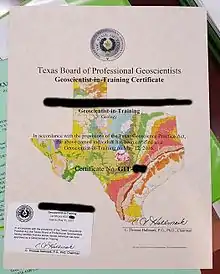
Geoscientist in Training, or GIT is a professional designation from the National Association of State Boards of Geology (ASBOG) and other organizations, used in U.S. States which regulate the practice of Geology and related earth science fields.[1]
Requirements for GIT certification are generally as follows:[2]
- Completion of an accredited four year degree program with a minimum of 30 hours of geoscience coursework.
- Passing scores on the ASBOG Fundamentals of Geology exam, CSSE Fundamentals of Soil Science exam, or State Geophysics exam.
- References attesting to the applicant's ethical character.
Actual requirements may vary state to state, and upon completion a Geoscientist in Training (GIT) may be required to complete annual continuing education hours, as well as follow rules associated with their particular state board.[3] Receiving a GIT designation is one step along the path towards a Professional Geologist (PG) licensure.[4]
The Geoscientist in Training (GIT) certification and advancement to Professional Geologist (PG) is similar in structure to the Engineer in Training process.
References
- ↑ "Licensure Information". ASBOG. ASBOG. Archived from the original on 2016-04-23. Retrieved 2016-05-16.
- ↑ "Geoscientist-in-Training Certification Requirements and Application Procedure". Texas Administrative Code. State of Texas. Retrieved 2016-05-16.
- ↑ "Use of the Title "Geoscientist-in-Training"". Texas Administrative Code. State of Texas.
- ↑ "Geoscientist-in-Training (GIT)". Texas Administrative Code. State of Texas. Retrieved 2016-05-16.